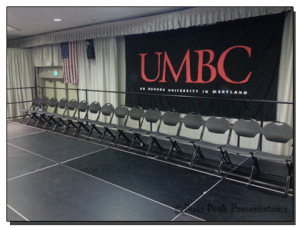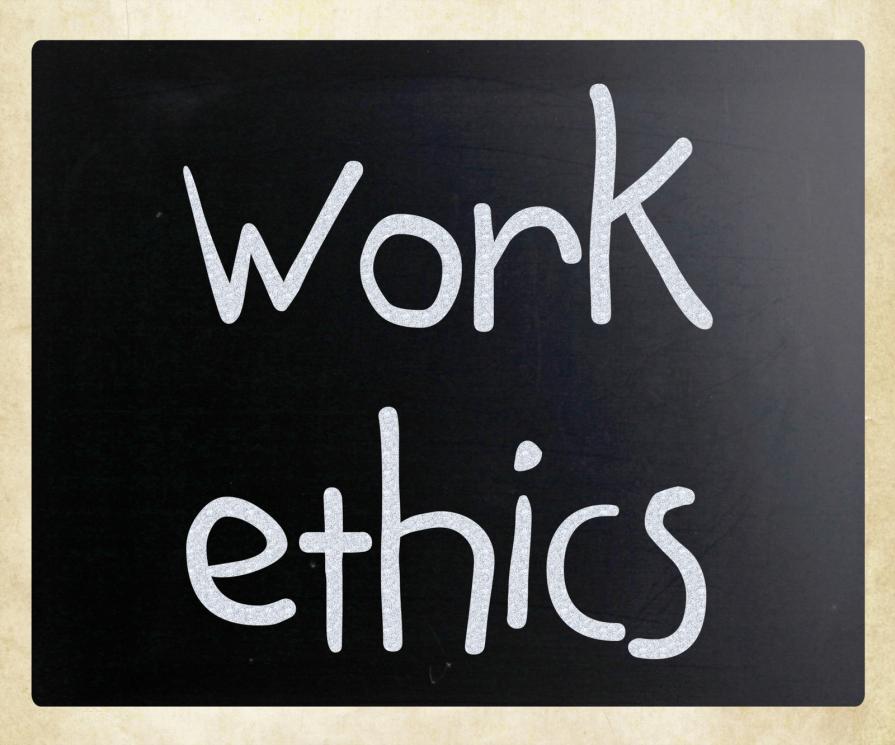Stage Hypnotist Tells How To Set Up A Safe & Fun Comedy Hypnosis Show
How To Set Up A Safe & Fun Comedy Hypnosis Show
Master Hypnotist Russ Peak Shows You How To Make Your Upcoming Hypnosis Show Safe & Fun For Everyone.
If you’re reading this article, you’ve probably decided to host a comedy hypnosis show for your next banquet, comedy night assembly, or fundraiser. Stage hypnosis can be one of the most exciting types of variety entertainment you and your audience will ever experience! This article will show you step-by-step how to set up a stage hypnotist show.
I’ve been a Comedy Stage Hypnotist for over 17 years. During that time, I’ve hypnotized folks in large theatres, banquet rooms, gymnasiums, back yard lawns, restaurants, and just about every type of venue imaginable. Something I’ve learned is that the set-up of a hypnotist show has tons to do with how well the show goes. So on this page I am going to show you how to set up your stage hypnotist show in a safe and effective way.
All you need is…
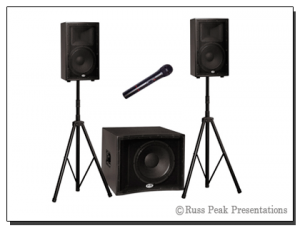
A Sound System
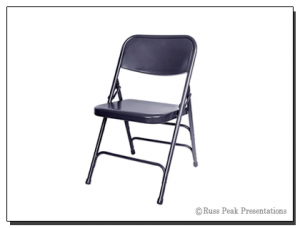
20-30 Chairs

An Eager Group of Volunteers
I. LIGHTING
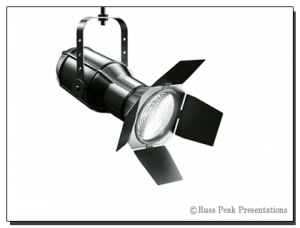
We’ll start with the simple part – Lighting. Of course we need lights for a show. How else are we supposed to see the hypnotized subjects do all that wild stuff your stage hypnotist has them do? But to be honest, lighting is one of the areas of least concern for a show. Unless on a formal stage the option is usually off or on. I tend to move around a lot during my shows and am constantly interacting with the audience. Plus, sometimes a few people get hypnotized right where they’re seated in the audience. So, I’ve found it works best if you leave the full house lights on during the program. Besides, studies show that your group will remember more and laugh more with full lights on.
II. THE STAGE
You will need to provide an adequate stage or space for your stage hypnotist show. Don’t worry, one of the great things about stage hypnosis is that it can be performed almost anywhere. The two important things are safety and space. Make sure you have at lease, a 16′ x 28′ space, big enough to fit at least 20-30 chairs across the stage – one row. The bigger the stage area the better. Also, the bigger the stage, the more chairs (and volunteers) that can be included in the hypnosis demonstration. And YES, a school gymnasium will be just fine.
* A cement or concrete performing area is never a safe choice.
Here’s a few examples of a good hypnosis show stage set up:
Riser Stage At University of Maryland
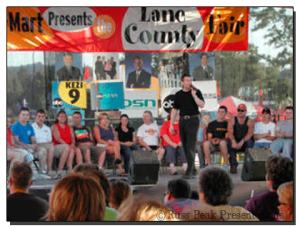
Outdoor Stage At Lane County Fair

Yes – A gym floor works GREAT!
REMEMBER:
The host of the hypnotist show (not the hypnotist) will usually assume responsibility for the safety of the riser or stage area, steps to the stage, and the chairs to be used during the performance. Make sure all equipment is good condition. With so many audience participants, we do not want to take a chance of an injury.
III. AUDIO
Supply your hypnotist with a sound system that’s equipped with a hand-held WIRELESS microphone. Again, always use a wireless microphone for your hypnotist show. Unsecured cords are a potential hazard for tripping and make it difficult to move around a stage full of volunteers.

A Sound System
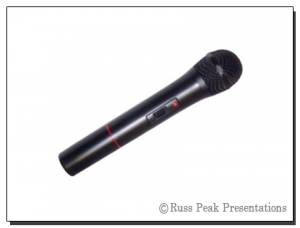
Hand Held Wireless Microphone
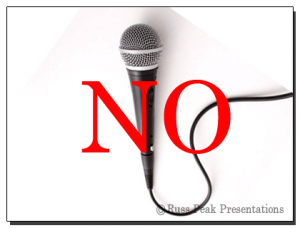
Corded Microphones Are A Hazard.
* It is important that the volunteers can hear your hypnotist from where they will be seated in the chairs on the stage. If they can’t hear… they don’t get hypnotized. In the case of a deep stage or a noisy environment like a fair or festival, use a monitor, pointed back toward the volunteers to allow easy listening to relax and enter hypnosis. In any case, remember that good sound is crucial to the success of your program. If your sound system and microphone are not adequate, borrow or rent quality equipment.
IV. SAFETY TIPS
HYPNOSIS SHOW SAFETY TIP #1: Sweep and Inspect performance area.
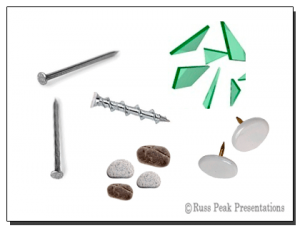
Sweep the stage or floor around performance area and check for nails, rocks, tacks, broken glass, liquid spills, or any other hazards. Hypnotized subjects may slide out of their chairs or end up on the stage area floor. It’s never fun to get poked by a sharp object or wake up covered in dirt from a filthy stage.
HYPNOSIS SHOW SAFETY TIP #2: Remove the podium/tables or other stage hazards.

If using a podium before or after the performance, please position podium to the far ‘stage’ right of stage or remove completely. If there is an Orchestra Pit in front of your stage, make sure it’s covered.
HYPNOSIS SHOW SAFETY TIP #3: Help the hypnotist keep your volunteers safe.

Keeping an eye on a large number of hypnotized subjects can be a difficult task. Plus, if this is a company or school event, you’ll likely know your audience members better than your hypnotist. If you see someone that is very intoxicated, injured, or might be hazardous to the show come on stage – by all means… intervene! If possible have someone assigned to stay near the stage to be an extra set of eyes for your hypnotist.
HYPNOSIS SHOW SAFETY TIP #4: Tape down any loose electrical, microphone, and speaker cables.

When I asked my insurance company what is the number one reason why people get injured on any stage, they replied that it was injury by unsecured cords. So, tip #4 is make sure all extension cords, wires, or cables are taped down to avoid volunteers tripping. Also, if someone trips over your cable it may damage the cord and/or your expensive sound equipment.
*** I recommend ‘Gaffers Tape’ over Duct Tape. It’s strong and doesn’t leave the sticky residue.
HYPNOSIS SHOW SAFETY TIP #5: Inspect the condition of the chairs.
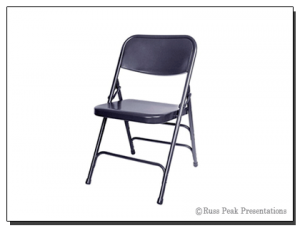
Make sure that the chairs that will be used for volunteers are in good condition. As an extra precaution, secure the chairs with Gaffers Tape. Volunteers often slide out of their chairs. Tapping the chairs as illustrated below will ensure volunteers don’t slide in between chairs, or the chair doesn’t fall on top of them.
For optimal safety, use Gaffers Tape to secure your chairs together. This will prevent chairs falling over as some hypnotized people tend to slide out of their chairs.
I’ve used red arrows to show you where I’ve placed tape on the chairs:
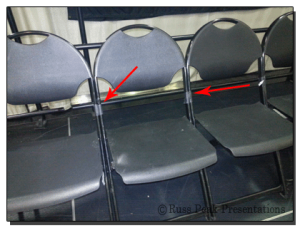
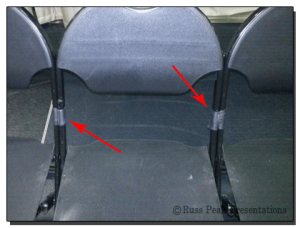
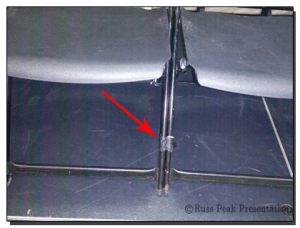
Here’s a view from the back:
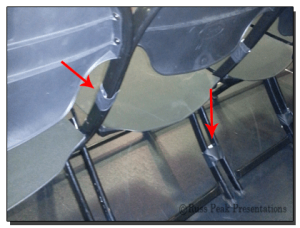
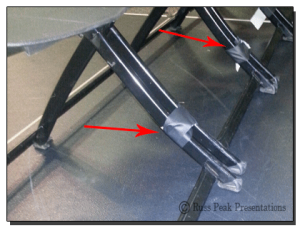
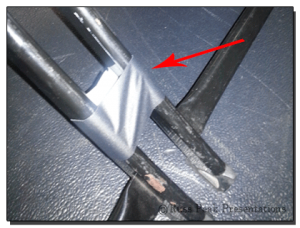
Have more questions about how to make your upcoming hypnosis show a safe and successful experience? Give me a call 971.241.3879 if you have any questions. I want to help you make your show SAFE! Anything to add? Leave your comments below!
Public Speaking 101
Your purpose is to make your audience see what you saw, hear what you heard, feel what you felt. Relevant detail, couched in concrete, colorful language, is the best way to recreate the incident as it happened and to picture it for the audience – Dale Carnegie
If facing a large audience gives you shivers, and the thought of public speaking gives you pangs of nervousness, make sure to follow these basic guidelines before you prepare for your next public speech or presentation.
Make the introduction gripping, and the content clear and concise
The content of your speech is the backbone of your success. Remember that first impressions are the last ones too, and aim to capture the attention of your listeners with your first expression. Starting with an inspirational quote, or a relevant short story, may work well to grip an audience. Ryan McLean highlights the importance of a captivating beginning by saying, “Your introduction needs to establish with the audience why it is important to them and why they should be listening to the speech.”
That being said, the quality of the main body is equally essential to ensure a successful outcome. The success of your presentation will be judged not by the knowledge you send out, but by what the listeners grasp from your words. Be understandable and assertive on your viewpoints; make sure you speak slowly, clearly, and thoughtfully. Keep the content to the point, avoid beating about the bush, and keep in mind the difference between a lecture and a speech. When determining the length of your content, take a hint from Dorothy Sarnoff’s advice, “Make sure you have finished speaking before your audience has finished listening.”
Confidence, composure, and poise
Undoubtedly, the most feared words of public speaking. You may be trying your best to avoid eye contact or imagining there is no one in the room, but as dreaded as it is, eye contact and speaking with confidence is extremely vital for an exceptional public act. It is absolutely vital for a public speaker to know the difference between ‘public reading’ and ‘public speaking’. Your audience is not there to watch your head hanging down as you read from a piece of paper. Make sure to be well-dressed, keep your hands out of your pocket, and stand tall and erect without moving a lot.
Public speaking is only 10% what you deliver and 90% how you deliver. Make sure you have researched well on your facts and figures, and confidently convey it to your listeners to make them believe in your potential and credibility. Keep it engaging and smooth by focusing your gaze on the audience as you speak and redirecting it to different listeners through the act.
Stay calm under unexpected problems
Broken multimedia, faulty projectors and whistling speakers are a common sight at conferences and corporate meetings. It is completely normal to experience technology hitches, unforeseen accidents, unnecessary interruptions, or simply going blank during your speech, or presentation. Stay calm under pressure, crack a joke, avoid being over apologetic, and most importantly never bury your face in your hands! Express your need for a pause to recollect your thoughts and resume once you are ready. Your tactful demeanor and quick recovery from a setback may leave your audience even more impressed.
Stage Hypnotist Tells How To Set Up A Safe & Fun Comedy Hypnosis Show
How To Set Up Your Comedy Hypnosis Show
Master Hypnotist Russ Peak Shows You How To Make Your Upcoming Hypnosis Show Safe & Fun For Everyone.
If you’re reading this article, you’ve probably decided to host a comedy hypnosis show for your next banquet, comedy night assembly, or fundraiser. Stage hypnosis can be one of the most exciting types of variety entertainment you and your audience will ever experience! This article will show you step-by-step how to set up a stage hypnotist show.
I’ve been a Comedy Stage Hypnotist for over 17 years. During that time, I’ve hypnotized folks in large theatres, banquet rooms, gymnasiums, back yard lawns, restaurants, and just about every type of venue imaginable. Something I’ve learned is that the set-up of a hypnotist show has tons to do with how well the show goes. So on this page I am going to show you how to set up your stage hypnotist show in a safe and effective way.
All you need is…

A Sound System

20-30 Chairs

An Eager Group of Volunteers
I. LIGHTING

We’ll start with the simple part – Lighting. Of course we need lights for a show. How else are we supposed to see the hypnotized subjects do all that wild stuff your stage hypnotist has them do? But to be honest, lighting is one of the areas of least concern for a show. Unless on a formal stage the option is usually off or on. I tend to move around a lot during my shows and am constantly interacting with the audience. Plus, sometimes a few people get hypnotized right where they’re seated in the audience. So, I’ve found it works best if you leave the full house lights on during the program. Besides, studies show that your group will remember more and laugh more with full lights on.
II. THE STAGE
You will need to provide an adequate stage or space for your stage hypnotist show. Don’t worry, one of the great things about stage hypnosis is that it can be performed almost anywhere. The two important things are safety and space. Make sure you have at lease, a 16′ x 28′ space, big enough to fit at least 20-30 chairs across the stage – one row. The bigger the stage area the better. Also, the bigger the stage, the more chairs (and volunteers) that can be included in the hypnosis demonstration. And YES, a school gymnasium will be just fine.
* A cement or concrete performing area is never a safe choice.
Here’s a few examples of a good hypnosis show stage set up:
Riser Stage At University of Maryland

Outdoor Stage At Lane County Fair

Yes – A gym floor works GREAT!
REMEMBER:
The host of the hypnotist show (not the hypnotist) will usually assume responsibility for the safety of the riser or stage area, steps to the stage, and the chairs to be used during the performance. Make sure all equipment is good condition. With so many audience participants, we do not want to take a chance of an injury.
III. AUDIO
Supply your hypnotist with a sound system that’s equipped with a hand-held WIRELESS microphone. Again, always use a wireless microphone for your hypnotist show. Unsecured cords are a potential hazard for tripping and make it difficult to move around a stage full of volunteers.

A Sound System

Hand Held Wireless Microphone

Corded Microphones Are A Hazard.
* It is important that the volunteers can hear your hypnotist from where they will be seated in the chairs on the stage. If they can’t hear… they don’t get hypnotized. In the case of a deep stage or a noisy environment like a fair or festival, use a monitor, pointed back toward the volunteers to allow easy listening to relax and enter hypnosis. In any case, remember that good sound is crucial to the success of your program. If your sound system and microphone are not adequate, borrow or rent quality equipment.
IV. SAFETY TIPS
HYPNOSIS SHOW SAFETY TIP #1: Sweep and Inspect performance area.

Sweep the stage or floor around performance area and check for nails, rocks, tacks, broken glass, liquid spills, or any other hazards. Hypnotized subjects may slide out of their chairs or end up on the stage area floor. It’s never fun to get poked by a sharp object or wake up covered in dirt from a filthy stage.
HYPNOSIS SHOW SAFETY TIP #2: Remove the podium/tables or other stage hazards.

If using a podium before or after the performance, please position podium to the far ‘stage’ right of stage or remove completely. If there is an Orchestra Pit in front of your stage, make sure it’s covered.
HYPNOSIS SHOW SAFETY TIP #3: Help the hypnotist keep your volunteers safe.

Keeping an eye on a large number of hypnotized subjects can be a difficult task. Plus, if this is a company or school event, you’ll likely know your audience members better than your hypnotist. If you see someone that is very intoxicated, injured, or might be hazardous to the show come on stage – by all means… intervene! If possible have someone assigned to stay near the stage to be an extra set of eyes for your hypnotist.
HYPNOSIS SHOW SAFETY TIP #4: Tape down any loose electrical, microphone, and speaker cables.

When I asked my insurance company what is the number one reason why people get injured on any stage, they replied that it was injury by unsecured cords. So, tip #4 is make sure all extension cords, wires, or cables are taped down to avoid volunteers tripping. Also, if someone trips over your cable it may damage the cord and/or your expensive sound equipment.
*** I recommend ‘Gaffers Tape’ over Duct Tape. It’s strong and doesn’t leave the sticky residue.
HYPNOSIS SHOW SAFETY TIP #5: Inspect the condition of the chairs.

Make sure that the chairs that will be used for volunteers are in good condition. As an extra precaution, secure the chairs with Gaffers Tape. Volunteers often slide out of their chairs. Tapping the chairs as illustrated below will ensure volunteers don’t slide in between chairs, or the chair doesn’t fall on top of them.
For optimal safety, use Gaffers Tape to secure your chairs together. This will prevent chairs falling over as some hypnotized people tend to slide out of their chairs.
I’ve used red arrows to show you where I’ve placed tape on the chairs:



Here’s a view from the back:



Have more questions about how to make your upcoming hypnosis show a safe and successful experience? Give me a call 971.241.3879 if you have any questions. I want to help you make your show SAFE! Anything to add? Leave your comments below!
How To Improve Your Professional Ethics
Careless or professional, a person’s work ethics can make or break his/her reputation at work and career growth. Increase your professional ethics by evaluating your current attitudes towards work, identify your pitfalls and take help from these five easy tips to have stronger work ethics and a fulfilling professional life.
Be dedicated and punctual
Strong work ethics are reflected by an employee’s dedication and commitment to his job. Maintain a regular attendance, take responsibility and ownership for your performance, remain focused on your targets, and put in extra efforts to complete your assignments to the best of your ability. You may need to occasionally dedicate a few extra hours, but take it as your chance to outshine the rest of employees.
Your punctuality at work speaks volumes about your professional ethics. Make sure you are on time to work and all work-related appointments. Submit your work in time, foresee delays, and let your employer know about your absences in advance.
Be reliable
Make sure to fulfill all promises and honor your project deadlines; in case you anticipate a delay, take your manager into confidence and set another realistic deadline. Being dependable is the backbone of maintaining an ethical reputation, and induces a relationship of trust between the employer and employees as well as between coworkers by showing that you prove what you portray.
Aim high in productivity and quality of work
Sometimes just working to keep your job intact is not enough. Those with good work ethics remain vigilant about their quality of work. Avoid being a passenger in your team and become a productive member instead. Your quality of work ultimately integrates into the company’s overall quality and reputation.
Finish your assigned tasks before the shift ends and strive to earn a better project next time. Be competitive yet attentive to instructions and details. Don’t hesitate to get help, even when you are leading. Set a standard of quality for you to achieve and take initiative to get projects started instead of waiting to be asked. Your positivity, problem-solving skills, flexibility, communication skills, and openness to feedback will always come in handy to earn you a good reputation at work.
Be cooperative to your co-workers and respectful of your work resources
Respect your peers, be willing to help them and avoid getting interfering or too personal in your interactions. Maintain healthy professional relationships with your coworkers to make collaborations and teamwork go smoother. Be an important contributor to your team and help them meet collective objectives.
To increase your professional ethics, it is absolutely vital that you remain respectful of your work time and resources. Respect the company’s privacy and data protection policies; use office time to work instead of personal engagements, save lunch breaks for personal chats with colleagues and treat all equipment and supplies with care. Your appearance reflects your work ethics, so make sure to dress professionally and maintain a moderate attitude.
Demonstrate a strong character
A good work ethic and a strong character are synonymous to each other in a workplace. Stay modest about your achievements and honest about your setbacks, and foster a trusting bond with clients, managers and colleagues by offering them honest feedback and advice. Your high moral standards, self discipline, and self-motivation will distinguish for the rest of the workforce and convince your supervisors of your loyalty to the company and non-problematic nature.
Icebreakers: From a Bunch to a Team
Do you remember going to an event where you never left your seat or exited the event without getting to know the name of the person sitting in front of you? If yes, then the event planners may have not paid enough heed to the icebreakers!
An effective and engaging way to start a public speaking event, training sessions, and team-building activities; icebreakers are the ‘hook’ to grip an audience. Not only do they push the event off to a great start, but icebreakers also prove instrumental in getting the audience to know each other, to get acquainted with the objectives of the event, to keep them captivated throughout the proceedings and encourage their participation to the purpose of the event, which contributes to a successful outcome.
When should icebreakers be used?
Just as the name suggests, they should be used whenever you need to “break the ice” within the audience at an event or a meeting. An icebreaker is often used when people from different professional or cultural backgrounds, who may possibly not know each other at all, meet for a common purpose. The icebreaking activities should aim to quickly bond the people towards the event goal, uplift the comfort levels in a newly formed team, throw hints about the upcoming topics of the session, and get the facilitator, or the speaker, and the participants to know each other better.
What to use and where?
An icebreaker activity designed to kick start a high school motivational talk, would be certainly different from one targeted at a professional audience. Make sure to design the activity that is appropriate to the target audience and pertinent to the objective of the meeting. While a Human Bingo may offer a mighty kick off to a student’s networking event; beginning with a short quiz or by stating some relevant news or facts may be more suitable for professional environments. Some popular and effective icebreakers include:
A ‘Raise Your Hand’ round:
This versatile activity works well for any event, corporate or casual, and stimulates the energy level as the audience raises their hands in response to different questions or audience polls.
The Hook:
Start a story but don’t finish it! As your audience gets captivated by the events, stop by saying, “I’ll get back to this towards the end.” This will keep them engaged till the end of the session.
Two Truths, One Lie:
An interactive activity for introduction, this generally works well with smaller groups but can also be effectively employed by selecting random participants to discreetly tell three facts about themselves, of which two should be true and one a lie. The audience keeps guessing the lie in a poll until the participant reveals it.
Brainstorm and Problem Solving:
Tried and tested, these universal icebreakers can either be used to start an event or in the middle, to boost the energy level and creativity of the participants. Get the group organized into smaller teams and assign a simple problem scenario for them to brainstorm and work out in a short time. Each group should then be asked to present their solutions to the other teams. This activity can be used to potentially go through multiple topics in a short span of time.
When designing your icebreaker, it is important to remember that while a good icebreaker can make a successful event, a poor one can break the entire tempo. While activities may always come in handy to mobilize the audience and keep them keyed up, starting off with a joke or an interesting quote may also work as an effective icebreaker to give your audience a promising impression of the event.


